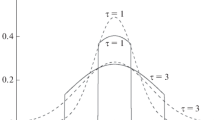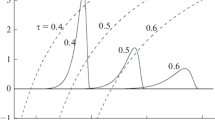Summary
A method is presented for the calculation of differential energy spectra for cosmic-ray particles at different zenith angles in the atmosphere. Special emphasis is laid on the angular dependence of differential cross-sections for various collision models and decay processes, the deflections of particle trajectory due to the multiple scattering and to the bending in the geomagnetic field are taken into account in the propagation. As an application, the muon intensities in the energy range (10/6000) GeV and at large zenith angles (θ>80°) at sea level were calculated by using two well-known models for the particle production in the collisions. The differences in the resulting muon spectra increase with increasing zenith angle and with increasing energy. The effects of the multiple scattering on the muon intensities are negligible except in the range (10/30) GeV, whore the neglect of the multiple scattering causes a reduction of the intensities which is about 20% at the highest. The vertical intensities are calculated for the range (1/3000) GeV. The predicted intensities are in agreement with the recent measurements of Allkoferet al. (1971).
Riassunto
Si presenta un metodo per il calcolo degli spettri dell’energia differenziale per particelle dei raggi cosmici a diversi angoli zenitali nell’atmosfera. Si mette in particolare rilievo la dipendenza angolare delle sezioni d’urto differenziali per vari modelli di collisione e processi di decadimento ; si tiene conto delle deflessioni della traiettoria delle particelle dovnte allo scattering multiplo e alla curvatura del campo geomagnetico nella propagazione. Corne applicazione si sono calcolate le intensità dei muoni nell’intervallo di energia (10/6000) GeV e per grandi angoli zenitali (θ>80°) al livello del mare facendo uso di due ben noti modelli per la produzione di particelle nelle collisioni. Le differenze negli spettri muoni risultanti crescono al crescere dell’angolo zenitale e dell’energia. Grli effetti dello scattering multiplo sulle intensità dei muoni sono trascurabili salvo che nell’intervallo (10/30) GeV, dove il trascurare lo scattering multiplo causa una riduzione delle intensità che è al massimo di circa il 10%. Si calcolano le intensità verticali per l’intervallo (1/3000) GeV. Le intensità predette concordano con le recenti misure di Allkoferet al. (1971).
Резюме
Предлагается метод д ля вычисления дифференциальных эн ергетических спектров для частиц к осмических лучей при различных зенитных углах в атмосфере. Особое вни мание уделяется угло вой зависимости диффере нциальных поперечных сечений д ля различных моделей соударений и процессов распада. П ри распространении учи тываются отклонения траекторий частиц, обусловленны е многократным рассеянием и изгибом геомагнитного поля. К ак приложение, вычисляю тся интенсивности мюоно в в области энергий (10/6000) Г эВ и при больших зенитных углах (θ > 80°) на уровне мо ря. При вычислении используются две хор ошо известные модели для рождения ч астиц при соударения х. Различия в полученных мюонных спектрах увеличиваю тся с увеличением зен итного угла и с увеличением энерг ии. Влияние многократно го рассеяния на интен сивности мюонов является прен ебрежимо малым, за исключением области (10/30)ГэВ, где пренебрежение много кратным рассеянием приводит к уменьшению интенси вностей, которое составляет с амое большое около 20%. Вычисл яются вертикальные интенсивности для об ласти (1/3000) ГэВ. Предсказанные и нтенсивности соглас уются с недавними измерения ми Аллкофера и др.
Similar content being viewed by others
References
J. E. Allen andA. J. Apostolakis:Proc. Roy. Soc, A265, 117 (1961).
F. Ashton, Y. Kamita, P. K. MacKeown, J. L. Osbokne, J. B. M. Pattison, P. V. Kamana Murtht andA. W. Woleendale:Proc. Phys. Soc.,87, 79 (1966).
J. L. Lloyd andA. W. Wolfendale:Proc. Phys. Soc.,68, 1045 (1955).
K. O’Brien:Nuovo Cimento,3 A, 521 (1971).
B. Rossi andK. Greisen:Rev. Mod. Phys.,13, 262 (1941).
C. E. Magnuson, J. R. Wayland andP. J. Green:Phys. Bev. D,6, 2431 (1972).
G. Brooke, P. J. Hayman, Y. Kamita andA. W. Wolfendale:Proc. Phys. Soc.,83, 853 (1964).
V. V. Akimov, N. L. Grigorov, I. D. Rapoport, V. Te. Nesterov, I. A. Savenko, G. A. Skuridin andA. F. Titenkov:Geomagn. and Aeron. (USSR), p. 385–8, English translation:Geomagn. and Aeron.,11, 327 (1971).
G. Cocconi, L. J. Koester andD. H. Perkins : UCRL-10022 (1961), p. 167.
Gr. Triling: Lawrence Radiation Laboratory Eeport UCID-10148 (1966).
J. Ranft andT. Borak:Improved nucleon-meson cascade calculations, FN-193, 1100.0, National Accelerator Laboratory (1969). The data are from:J. Ranft:Two computer programmes to calculate and plot secondary particle yields according to various formulae (CERN Programme Library No. W 129) CERN-PS/6168, 20 Oct. 1967.
B. Rossi:High-Energy Particles (Englewood Cliffs., N.J., 1952), p. 544.
S. F. Singer andA. M. Lenchek: Chapter III inProgress in Elementary Particle and Cosmic Bay Physics, Vol.6, edited byJ. G. Wilson andS. A. Wouthuysen (Amsterdam, 1962), p. 260.
O. C. Allkofer, K. Carstensen andW. D. Dau:Phys. Lett.,36 B, 425 (1971).
Author information
Authors and Affiliations
Rights and permissions
About this article
Cite this article
Torsti, J.J., Terho, R.W. Angular effects in the propagation of cosmic rays in the atmosphere. Nuov Cim B 16, 376–386 (1973). https://doi.org/10.1007/BF02828691
Received:
Published:
Issue Date:
DOI: https://doi.org/10.1007/BF02828691




